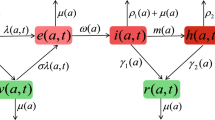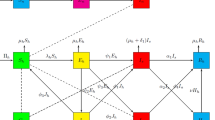Abstract
Mathematical modelling of infectious diseases has shown that combinations of isolation, quarantine, vaccine and treatment are often necessary in order to eliminate most infectious diseases. However, if they are not administered at the right time and in the right amount, the disease elimination will remain a difficult task. Optimal control theory has proven to be a successful tool in understanding ways to curtail the spread of infectious diseases by devising the optimal diseases intervention strategies. The method consists of minimizing the cost of infection or the cost of implementing the control, or both. This paper reviews the available literature on mathematical models that use optimal control theory to deduce the optimal strategies aimed at curtailing the spread of an infectious disease.
Similar content being viewed by others
References
Adams, B. M., Banks, H. T., Davidian, M., Kwon, H., Tran, H. T., Wynne, S. N., & Rosenberg, E. S. (2005). HIV dynamics: Modeling, data analysis, and optimal treatment protocols. Journal of Computational and Applied Mathematics, 184(1), 10–49. Special Issue on Mathematics Applied to Immunology Special Issue on Mathematics Applied to Immunology.
Agusto, F. B. (2013). Optimal isolation control strategies and cost-effectiveness analysis of a two-strain avian influenza model. Biosystems, 113(3), 155–164.
Agusto, F. B., & Adekunle, A. I. (2014). Optimal control of a two-strain tuberculosis-hiv/aids co-infection model. Biosystems, 119, 20–44.
Anita, S., Capasso, V., Kunze, H., & La Torre, D. (2013). Optimal control and long-run dynamics for a spatial economic growth model with physical capital accumulation and pollution diffusion. Applied Mathematics Letters, 26(8), 908–912.
Aouni, B., Colapinto, C., & La Torre, D. (2014). Financial portfolio management through the goal programming model: Current state-of-the-art. European Journal of Operational Research, 234(2), 536–545. 60 years following Harry Markowitzs contribution to portfolio theory and operations research.
Apreutesei, N., Dimitriu, G., & Strugariu, R. (2014). An optimal control problem for a two-prey and one-predator model with diffusion. Computers and Mathematics with Applications, 67(12), 2127–2143. Efficient Algorithms for Large Scale Scientific Computations.
Belad, A., Cinzia, C., & La Torre, D. (2013). A cardinality constrained stochastic goal programming model with satisfaction functions for venture capital investment decision making. Annals of Operations Research, 205(1), 77–88.
Bowong, S., & Aziz Alaoui, A. M. (2013). Optimal intervention strategies for tuberculosis. Communications in Nonlinear Science and Numerical Simulation, 18(6), 1441–1453.
Brown, V. L., & Jane White, K. A. (2011). The role of optimal control in assessing the most cost-effective implementation of a vaccination programme: {HPV} as a case study. Mathematical Biosciences, 231(2), 126–134.
Buonomo, B., Lacitignola, D., & Vargas-De-Len, C. (2014). Qualitative analysis and optimal control of an epidemic model with vaccination and treatment. Mathematics and Computers in Simulation, 100, 88–102.
Chiang, A. C. (1992). Elements of dynamic optimization. New York, NY: McGraw-Hill international editions, McGraw-Hill. [u.a.], internat. ed. edition.
Costanza, V., Rivadeneira, P. S., Biafore, F. L., & DAttellis, C. E. (2013). Optimizing thymic recovery in HIV patients through multidrug therapies. Biomedical Signal Processing and Control, 8(1), 90–97.
Fleming, W. H., & Rishel, R. W. (1975). Deterministic and stochastic optimal control. New York: Springer.
Forster, M., La Torre, D., & Lambert, P. J. (2014). Optimal control of inequality under uncertainty. Mathematical Social Sciences, 68, 53–59.
Graesboll, K., Enoe, C., Bodker, R., & Engbo Christiansen, L. (2014). Optimal vaccination strategies against vector-borne diseases. Spatial and Spatio-temporal Epidemiology, 11, 153–162.
Hethcote, Herbert W. (2000). The mathematics of infectious diseases. SIAM Review, 42(4), 599–653.
Imran, M., Rafique, H., Khan, A., & Malik, T. (2014). A model of bi-mode transmission dynamics of hepatitis c with optimal control. Theory in Biosciences, 133(2), 91–109.
Karrakchou, J., Rachik, M., & Gourari, S. (2006). Optimal control and infectiology: Application to an hiv/aids model. Applied Mathematics and Computation, 177(2), 807–818.
Kermack, W. O., & McKendrick, A. G. (1927). A contribution to the mathematical theory of epidemics. Proceedings of the Royal Society of London. Series A, 115(772), 700–721.
Kim, B. N., Nah, K., Chu, C., Ryu, S. U., Kang, Y. H., & Kim, Y. (2012). Optimal control strategy of plasmodium vivax malaria transmission in korea. Osong Public Health and Research Perspectives, 3(3), 128–136.
Kwon, H. (2007). Optimal treatment strategies derived from a {HIV} model with drug-resistant mutants. Applied Mathematics and Computation, 188(2), 1193–1204.
Kwon, H., Lee, J., & Yang, S. (2012). Optimal control of an age-structured model of {HIV} infection. Applied Mathematics and Computation, 219(5), 2766–2779.
La Torre, D., & Marsiglio, S. (2010). Endogenous technological progress in a multi-sector growth model. Economic Modelling, 27(5), 1017–1028.
Lashari, A. A., & Zaman, G. (2012). Optimal control of a vector borne disease with horizontal transmission. Nonlinear Analysis: Real World Applications, 13(1), 203–212.
Lee, K. S., & Lashari, A. A. (2014). Stability analysis and optimal control of pine wilt disease with horizontal transmission in vector population. Applied Mathematics and Computation, 226, 793–804.
Lenhart, S., & Workman, J. T. (2007). Optimal control applied to biological models. Mathematical and computational biology. Boca Raton (Fla.), London: Chapman & Hall/CRC.
Lowden, J., Miller Neilan, R., & Yahdi, M. (2014). Optimal control of vancomycin-resistant enterococci using preventive care and treatment of infections. Mathematical Biosciences, 249, 8–17.
Makinde, O. D., & Okosun, K. O. (2011). Impact of chemo-therapy on optimal control of malaria disease with infected immigrants. Biosystems, 104(1), 32–41.
Marco, M., & La Torre, D. (2012). A goal programming model with satisfaction function for risk management and optimal portfolio diversification. INFOR: Information Systems and Operational Research, 20(3), 117–126.
Moualeu, D. P., Weiser, M., Ehrig, R., & Deuflhard, P. (2015). Optimal control for a tuberculosis model with undetected cases in cameroon. Communications in Nonlinear Science and Numerical Simulation, 20(3), 986–1003.
Okosun, K. O., Ouifki, R., & Marcus, N. (2011). Optimal control analysis of a malaria disease transmission model that includes treatment and vaccination with waning immunity. Biosystems, 106(23), 136–145.
Okosun, K. O., Makinde, O. D., & Takaidza, I. (2013). Impact of optimal control on the treatment of hiv/aids and screening of unaware infectives. Applied Mathematical Modelling, 37(6), 3802–3820.
Okosun, K. O., Rachid, O., & Marcus, N. (2013). Optimal control strategies and cost-effectiveness analysis of a malaria model. Biosystems, 111(2), 83–101.
Okosun, K. O., & Makinde, O. D. (2014). A co-infection model of malaria and cholera diseases with optimal control. Mathematical Biosciences, 258, 19–32.
Orellana, J. M. (2011). Optimal drug scheduling for HIV therapy efficiency improvement. Biomedical Signal Processing and Control, 6(4), 379–386.
Paolo, P., Martin, F., & La Torre, D. (2014). Optimal bayesian sequential sampling rules for the economic evaluation of health technologies. Journal of the Royal Statistical Society: Series A (Statistics in Society), 177(2), 419–438.
Prosper, O., Ruktanonchai, N., & Martcheva, M. (2014). Optimal vaccination and bednet maintenance for the control of malaria in a region with naturally acquired immunity. Journal of Theoretical Biology, 353, 142–156.
Roshanfekr, M., Hadi Farahi, M., & Rahbarian, R. (2014). A different approach of optimal control on an {HIV} immunology model. Ain Shams Engineering Journal, 5(1), 213–219.
Silva, C. J., & Torres, D. F. M. (2013). Optimal control for a tuberculosis model with reinfection and post-exposure interventions. Mathematical Biosciences, 244(2), 154–164.
Su, Y., & Sun, D. (2015). Optimal control of anti-hbv treatment based on combination of traditional chinese medicine and western medicine. Biomedical Signal Processing and Control, 15, 41–48.
Whang, S., Choi, S., & Jung, E. (2011). A dynamic model for tuberculosis transmission and optimal treatment strategies in south korea. Journal of Theoretical Biology, 279(1), 120–131.
Yan, X., & Zou, Y. (2008). Optimal and sub-optimal quarantine and isolation control in {SARS} epidemics. Mathematical and Computer Modelling, 47(12), 235–245.
Zaman, G., Han Kang, Y., & Hyo Jung, I. (2008). Stability analysis and optimal vaccination of an {SIR} epidemic model. Biosystems, 93(3), 240–249.
Zarei, H., Vahidian Kamyad, A., & Effati, S. (2010). Multiobjective optimal control of hiv dynamics. Mathematical Problems in Engineering 2010 (Article ID 568315):1–29.
Zhou, Y., Liang, Y., & Wu, J. (2014). An optimal strategy for {HIV} multitherapy. Journal of Computational and Applied Mathematics, 263, 326–337.
Acknowledgments
The authors are grateful to the anonymous reviewers for their constructive comments, which have improved the manuscript.
Funding
This research was supported by Khalifa University Internal Research Fund (Grant No. 210032).
Conflict of Interest
The authors declare that they have no conflict of interest.
Author information
Authors and Affiliations
Corresponding author
Rights and permissions
About this article
Cite this article
Sharomi, O., Malik, T. Optimal control in epidemiology. Ann Oper Res 251, 55–71 (2017). https://doi.org/10.1007/s10479-015-1834-4
Published:
Issue Date:
DOI: https://doi.org/10.1007/s10479-015-1834-4




